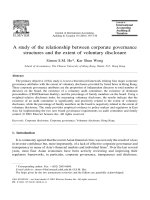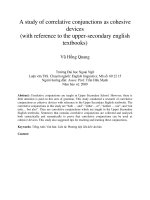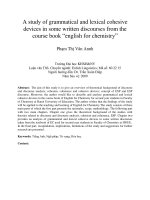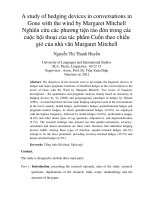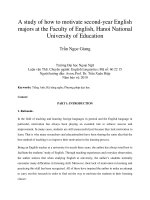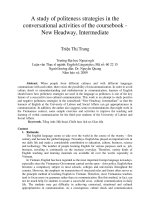A study of the effectiveness of intervention programs on household energy consumption
Bạn đang xem bản rút gọn của tài liệu. Xem và tải ngay bản đầy đủ của tài liệu tại đây (1.01 MB, 94 trang )
A STUDY OF THE EFFECTIVENESS OF INTERVENTION
PROGRAMS ON HOUSEHOLD ENERGY CONSUMPTION
HE HENGZHAO
(B. Eng., Tsinghua University)
A THESIS SUBMITTED
FOR THE DEGREE OF MASTER OF SCIENCE (BUILDING)
DEPARTMENT OF BUILDING
NATIONAL UNIVERSITY OF SINGAPORE
2011
i
Acknowledgements
I wish to express my deepest gratitude to the following persons, without whose
assistance and support, the dissertation could not be finished.
Assistant Professor Kua Harn Wei, my supervisor, for his invaluable advice and
guidance throughout my study. His mentorship was paramount to the success of the
dissertation.
Professor Wong Nyuk Hien, my co-supervisor, for his insightful views on my
research.
Staff of Eco Singapore, Philipp Steinkemper, Tan Yi Han and Wilson Ang, for
their understanding of my objectives and help during the research process.
Mr Chew Hok Eng Freddie, other ITE College West teachers and students, for their
active participation in the intervention program.
Other relevant members from Hong Kah North RC and Southwest CDC, who
contributed to my completion of the dissertation.
My parents and family, for their love and support throughout my life.
ii
Table of Contents
Acknowledgements i
Summary vi
List of Tables viii
List of Figures ix
Abbreviations x
Chapter 1 Introduction 1
1.1 Background 1
1.2 Objectives and Scope of the Study 3
1.3 Organization of Dissertation 3
Chapter 2 Literature Review 5
2.1 Energy Usage Related to Residential Sector 5
2.1.1 Direct and Indirect Residential Energy 5
2.1.2 Facts about Singapore’s Residential Energy Consumption 7
2.2 Lessons from Past Intervention Programs 8
2.2.1 General Description 8
2.2.2 Antecedent Interventions 9
2.2.3 Consequence Interventions 13
2.2.4 Summary 15
2.3 Behavior and Theories for Pro-Environmental Behavior 16
2.3.1 Behavior and Energy Consumption 16
2.3.2 A Brief Overview of Behavior Theories 18
iii
2.3.3 Value and Behavior 20
2.3.4 Summary 23
2.4 Identification of Knowledge Gap 24
Chapter 3 Research Methodology 25
3.1 Research Hypotheses 25
3.2 Research Design 25
3.3 Sample Choosing 26
3.4 Grouping, Duration and Procedure 29
3.5 Questionnaire Design 32
3.5.1 Basic Information 32
3.5.2 Behavior Score 32
3.5.3 Quality of Life 34
3.5.4 Program Feedback 34
3.6 Data Collection and Processing 35
3.6.1 Data Collection 35
3.6.2 Data Processing 38
Chapter 4 Data Analysis 39
4.1 Basic Information 39
4.1.1 Groups 39
4.1.2 Ethnics 39
4.1.3 House Type 40
4.1.4 Number of People Living in Households 41
iv
4.1.5 Income 41
4.1.6 Education Level 42
4.2 Electricity Consumption and Gini Coefficient 42
4.3 Effectiveness of Interventions 46
4.3.1 Self-Reported Behavior Scores 46
4.3.2 Actual Electricity Consumption 50
4.4 QOL, Behaviors and Actual Consumption 53
4.4.1 Factor Analysis of QOL aspects 53
4.4.2 Regression Analysis for Behavior and Energy Consumption 55
4.4.3 Regression Analysis for Energy Saving 57
4.5 Feedback 59
Chapter 5 Conclusions 63
5.1 Review of Research Objectives and Verification of Hypotheses 63
5.1.1 Review of Objective 1 and Verification of Hypothesis 1 63
5.1.2 Review of Objective 2 and Verification of Hypothesis 2 63
5.1.3 Review of Objective 3 64
5.2 Contributions and Implications 65
5.3 Limitations 65
5.4 Recommendations 68
5.5 Suggestions for further research 68
5.5.1 Intervention Study 68
5.5.2 Pro-environmental Behavior 69
v
Bibliographies 71
Appendices 75
Appendix 1. Basic information questionnaire 75
Appendix 2. Behavior questionnaire for Group 1 (Leaflet) and 3 (Control) 76
Appendix 3. Behavior questionnaire for Group 2 (Tips) 78
Appendix 4. Quality of Life questionnaire 81
Appendix 5. Program feedback questionnaire 83
vi
Summary
Energy consumption is now becoming more and more critical due to climate
change and rising energy price. Unlike energy use in industrial or commercial
sectors, where energy is managed by professionals, residential energy consumption
is affected by millions of diverse residents and consumed on many types of
household appliances. In Singapore, energy is totally imported and more than 80%
of residents live in HDB blocks. Therefore, a household electricity energy saving
intervention program was done in HDB blocks in Hong Kah North district.
The research objectives are to: (1) compare the effectiveness of different
interventions based on self-reported behavior scores as well as actual electricity
saving; (2) investigate how behaviors and electricity consumption are influenced
by values and other demographics; (3) examine the methods of intervention used
according to residents’ feedback and make recommendations.
It is hypothesized that some interventions result in better results than others; and
people’s values are determinant factors for their decisions on pro-environmental
behaviors. The intervention program lasted six months and the method of
comparing treatment groups against control group was used. General information
in distributed materials (for households in Leaflet Group) and tailored information
through conversation (for those in Tips Group) were provided to two treatment
groups. Control Group received no information about energy saving. Surveys on
demographic variables, behavior, value (Quality of Life) and feedback were used to
collect data. Actual electricity consumption was also taken down.
vii
The results show that Tips Group had most self-reported behavior changes towards
an energy saving way with statistically significance. However, when it comes to
energy saving, Leaflet Group saved most. The average savings between the last
period of the program and the period before the start of the program were: Leaflet
Group saved 15.8%, Tips Group saved 7.1% and Control Group saved 2.7%.
People open to change with an emphasis on Traditional Family Value (family,
work, health and religion) were more likely to behave in an energy-saving way;
actual electricity consumption was positively correlated to number of people living
in, floor area and air-conditioner possession but none of the value dimensions.
However, the not so large explained variance indicates there are other factors
besides value aspects affecting pro-environmental behaviors and further study
should be done. The households living in larger apartments provided with
information on energy conservation saved more percentage of electricity.
Stickers were only pasted by half of the households and people had their own
preference towards intervention methods. Easiness of behavior, saving money and
environmental concern were found to be relatively important reasons for residents’
choices on pro-environmental behaviors. All these highlighted the importance of
giving the right interventions to different residents.
viii
List of Tables
Table 2-1 Singapore’s energy consumption by sectors in 2005
Table 2-2 Twenty-two Quality-of-Life aspects and their descriptions
Table 3-1 Different interventions for different groups
Table 4-1 Numbers of housholds in different groups
Table 4-2 Ethnic components of households
Table 4-3 Percentage of house types
Table 4-4 Number of peple living in households
Table 4-5 Income situation
Table 4-6 Education level of household members
Table 4-7 Average electricity consumption in different groups
Table 4-8 Percentage of electricity consumption per quintile of residents
Table 4-9 Number of positive changes in different groups
Table 4-10 Behavior scores for 21 behaviors and statistical results
Table 4-11 Hourly average temperature
Table 4-12 Change of electricity consumption during different periods
Table 4-13 Reliability statistics for behavior score and QOL
Table 4-14 Factor loadings after varimax rotation
Table 4-15 Regression results for behavior scores and actual consumption
Table 4-16 Regression results for actual electricity saving
Table 5-1 A method to describe family structure
ix
List of Figures
Figure 2-1 The innovation decision process
Figure 2-2 An integrated model of pro-environmental behavior
Figure 3-1 Research design
Figure 3-2 Map of the studied area
Figure 3-3 Schedule of intervention program
Figure 3-4 The way to provide tailored information in Tips Group
Figure 3-5 Five periods for comparison
Figure 4-1 Domestic electricity tariff during the program period
Figure 4-2 Lorenz curve and definition of Gini coefficient
Figure 4-3 Result: Lorenz curve
Figure 4-4 Score distribution for specific behaviors
Figure 4-5 Average percentage savings of different groups
Figure 4-6 Response to feeback
x
Abbreviations
ABC Attitude-Behavior-External Conditions
EU European Union
HDB Housing and Development Board
ITE Institute of Technical Education
NEA National Environment Agency
NUS National University of Singapore
QOL Quality of Life
RC Residential Council
SP Singapore Power
SPSS Statistical Package for the Social Sciences
SW CDC Southwest Community Development Council of Singapore
VBN Value-Belief-Norm
1
Chapter 1 Introduction
1.1 Background
Energy consumption has been a topic of interest for decades due to climate change
and rising energy price. The society’s total energy consumption can be divided into
three categories –industrial consumption, commercial consumption and residential
consumption. Compared to the other two sectors, residential energy conservation
faces a rather difficult task, for the reason that the energy use in the other two is
managed by professional and experienced teams, while residential energy use is
related to millions of diverse residents and consumed on various types of
household appliances.
Another important aspect for studying residential energy use in Singapore, which
should not be ignored, is that Singapore is a totally energy-importing country and
the small island’s environment is most vulnerable to climate change and global
warming. The main contribution to Singapore’s greenhouse gas emissions is
carbon dioxide and the construction and usage of buildings involve high levels of
energy consumption as well as greenhouse gas emissions. (Gunawansa, Kua, 2010;
Lutchmeeduth, Kua, Gunawansa, 2010) To complete its National Climate Change
Strategy and fulfill its commitment to the world to reduce carbon intensity,
Singapore emphasizes on enhancing residential energy efficiency and reducing
residential energy use.
In this study, residential energy refers to only electricity used within the household.
Though transportation and gas used by residents may also account for a great deal
of energy, they are neglected because transportation energy use is not easy to
2
measure precisely and gas consumption is not so common in Singapore’s public
housings.
How are residents in Singapore using energy? Is there any clear difference in
electricity consumption between different groups of people (for example, rich
versus poor; people using the most versus people using the least, etc.)? Residential
energy consumption is related to many factors, such as weather, building physical
characteristics, types of home appliances, how long and how home appliances are
used. To reduce residential energy consumption, attention is focused more on the
residents’ energy-using behaviors, how home appliances are used. That is a
relatively easy way to affect electricity consumption. Here is the reason: weather
and building physical characteristics are unlikely to change; if focusing on types of
home appliances, substantial additional spending becomes an unfavorable must; it
is possible to change the energy-related behaviors towards an energy-efficient way
without affecting people’s comfort too much.
In order to change residents’ behaviors effectively, theories on behaviors are
reviewed. Measurement of behaviors involves self-reported behavior scores. The
integrated VBN & ABC (value-belief-norm & attitude-behavior-external
conditions) model describing values, pro-environmental behaviors and other factors
(Stern, 2000) is used. In this study, it is believed that values affect beliefs, then
norms and finally behaviors and that is tested in the analysis. Besides, the
relationship between values, behaviors, demographics and energy consumption is
also investigated.
Last but not the least, what is the best way to influence the residents to change their
behaviors is another important issue in this study. There are quite a lot of useful
3
interventions: commitment, goal setting, information providing, modeling,
feedback and rewards. Each intervention can be further divided according to its
features and details and several interventions can be combined together to affect
energy conservation. In our study, the method of comparison between treatment
groups and a control group is used in order to obtain a good intervention.
1.2 Objectives and Scope of the Study
In view of the points above, residents’ energy use and the relationship between
their values and behaviors are main focus of the study. The objectives of the study
are as follows:
1. To compare the effectiveness of different interventions based on self-reported
behavior scores as well as actual electricity saving and find out a good way of
intervention;
2. To investigate how behaviors and electricity consumption are influenced by
values and other demographics;
3. To examine the methods of intervention used and make recommendations.
The core of the study is a household electricity energy saving intervention program
done in Hong Kah North HDB buildings. The intervention program lasts six
months. The effectiveness of interventions, self-behavior scores, values, and actual
electricity consumption are main topics discussed. Statistics methods are applied in
data analysis.
1.3 Organization of Dissertation
The outline of the dissertation can be described as follows:
4
Chapter 1 gives an overview of the dissertation and generalizes the background,
research objectives, the scope of the study and the organization of the dissertation.
Chapter 2 presents literature reviews on previous intervention programs aiming to
reduce energy consumption and different models for pro-environmental behaviors.
Chapter 3 describes the research methodology used in the study concretely. Details
about the intervention program and methods for data collection and data analysis
are covered.
Chapter 4 presents the results of data analysis. The demographical characteristics
are firstly discussed; the effectiveness of interventions is then compared according
to self-reported behavior scores and actual electricity consumption; Quality of Life
aspects are factored analyzed and regression models for behavior scores and
electricity consumption are tested; and finally analyze households’ feedback.
Chapter 5 brings in a conclusion to the dissertation and discusses about the
limitations of the research and suggestions for further studies.
5
Chapter 2 Literature Review
2.1 Energy Usage Related to Residential Sector
2.1.1 Direct and Indirect Residential Energy
“Residential energy” is an ambiguous phrase used by researchers. To define the
extent of residential energy is necessary before any further discussion. Energy
issues caught people’s attention firstly during the world energy crisis in the 1970s.
Shortages of petroleum resulted in economic recession and people’s awareness of
energy’s importance. Since then, researchers have put effort into the study of
residential energy conservation. Electricity, gas, oil and all other forms of energy
were all covered. Residential energy referred to energy consumed in the house.
The definition of “residential energy” was broadened later. Energy consumed in the
house, either in the form of electricity, natural gas, or petroleum, is defined as
“direct consumption”; energy embodied in goods and services which are purchased
by the household members, is called “indirect consumption”. Previous studies did
calculate embodied energy for different goods and services, but to view the
embodied energy as a part of residential energy provides insight for more
comprehensive understanding for energy consumption. There are reasons why the
comparison should not be made solely on direct consumption: supposing two
households, one household always buy take-away food, while the other always
cook and eat at home. That leads to more direct energy consumed in the latter
family and uncertain influence on households’ total energy consumption. If only
direct energy is considered, the conclusion may be flawed: people should not cook
at home. If one household spend weekends at home, and though they lead a life
without much energy consumed, energy is consumed. The other household usually
6
go out for recreation and takes airplane regularly. It is true that the latter spend less
on the bills but it is difficult to judge that they are more energy-saving.
The relationship between total energy, direct energy, income, expenditure and other
factors has been carefully analyzed. Herendeen (1978) found that in Norway direct
energy (either residential energy or auto fuel) consumed by families with different
income was almost of the same amount while the amount of total energy differed.
The relationship between energy requirement and household expenditure were
studied by Vringer and Blok (1995) and Reinders et al. (2003). They all found that
total household expenditure affected total energy requirement a lot and Reinders,
Vringer and Blok (2003) also found a linear relationship between indirect energy
requirement and total household expenditure; and the share of direct energy to the
total energy requirement of households in 11 European Union (EU) countries
varies from 34% up to 64%.
However, quality of most research on indirect consumption highly depends on
subjective responses from residents, including questions such as how much has
been used and how long an activity lasts. Data availability is a problem for the
reason that so many diverse activities are included in indirect energy consumption.
Reinders, Vringer and Blok (2003) excluded expenditure of certain categories in
his comparison of indirect energy use between EU members due to the reason of
structural differences between the economies and unacceptable quality of available
data.
To include indirect energy consumption in residential energy is fatal because
people now have a varied life compared to the old days and lots of activities
happen outside the house, the energy consumption of which is not considered in
7
direct energy consumption. If focus is on electricity and gas that is consumed in the
house, direct energy should be studied though indirect energy may also affect the
amount of direct energy consumption. If energy consumed by residents or carbon
dioxide emission is the main interest, total energy including direct and indirect
energy is an appropriate research objective.
2.1.2 Facts about Singapore’s Residential Energy Consumption
For Singapore, publicized literature on residential indirect energy consumption is
not found. Energy consumption of buildings (industrial, commercial as well as
residential) took up about a third of Singapore’s total electricity production. (Chua
and Chou, 2010) According to the National Energy Policy Report (2007),
Singapore’s residential direct energy consumption accounts for around 10% of
society’s total energy consumption in 2005 (shown in Table 2-1). This view is
widely used in various reports of Singapore governments that a typical Singapore
household spends about 50% of electricity bills on the air-conditioner and the
refrigerator.
Table 2-1 Singapore’s energy consumption by sectors in 2005
Percentage (%)
Power
generation
Industry Transport Buildings Households
Others
a
Fuel
consumption
51
b
32 16 <1 <1 -
Electricity
consumption
22 2 16 9 2
End-Use
consum
p
tion
~54 ~18 ~17 ~10 ~2
a. Includes consumption for utilities, communication, construction, agriculture, etc.
b. Electricity consumption is the part of power generation under the category of
fuel consumption.
Source: National Energy Policy Report, 2007.
8
2.2 Lessons from Past Intervention Programs
2.2.1 General Description
In order to reduce residential direct energy consumption, besides sustainable
building design and technology improvement which includes better heat insulation
material, energy efficient products and application of renewable energy systems,
lots of efforts were made on intervention programs. The purpose of interventions is
to change residents’ behavioral patterns towards an energy-saving manner and thus
impact on energy consumption.
Behaviors related to residential energy conservation can be divided into two
categories: efficiency and curtailment behaviors. (Gardner and Stern, 2002)
Efficiency behaviors are one-shot behaviors and require purchase of energy-
efficient equipment. Curtailment behaviors involve repetitive efforts to save energy
consumption. Gardner and Stern (2002) also identified energy-saving potential of
efficiency behaviors is greater than that of curtailment behaviors.
Two types of strategies are identified to promote household energy conservation.
Psychological strategies are aimed at changing people’s knowledge, perceptions,
motivation, cognitions and norms related to energy use and conservation. Examples
are the provision of information and modeling. Structural strategies are aimed at
changing the context in which decisions are made so as to make energy
conservation more attractive. Examples are new or better products and services,
changes in infrastructure, pricing policies and legal measures. (Steg, 2008)
Most interventions were only targeting at direct consumption while indirect
consumption was seldom discussed. Even for those with discussion on indirect
consumption, no significant difference of indirect energy savings existed. (Benders,
9
2006; Abrahamse et al., 2007) For the reason of limited literature of interventions
on indirect consumption, interventions reviewed below are all about direct
consumption.
The taxonomy for behavior change interventions, proposed by Geller et al. (1990)
to distinguish between antecedent and consequence interventions, is applied for the
classification of past intervention programs. Antecedent interventions mean the
influence is made before the behaviors. One of the examples is to provide energy-
saving knowledge to households. The key of antecedent interventions is whether
the determinants of behaviors are changed. Consequence interventions are based on
the assumption that positive consequences make people inclined towards pro-
environmental behaviors while negative consequences do the opposite. The
example is to provide useful information based on electricity bills. There are
mainly following types of antecedent interventions: commitment, goal setting,
information and modeling; and feedback and rewards are two main types of
consequence interventions. (Abrahamse et al., 2005)
2.2.2 Antecedent Interventions
2.2.2.1 Commitment and Goal Setting
A commitment is an oral or written pledge or promise to change behavior. A
commitment usually is combined with a goal setting, which gives a reference point
for energy reduction. A goal setting can be set by either the households themselves
or the experimenters. A commitment is literally of the households’ wishes.
Pallak and Cummings (1976) used commitment in the interventions with the aim of
reducing natural gas and electricity consumption. Information was provided to all
households in treatment groups. One treatment group was personally identified.
10
How much the energy changed would be communicated to the public by
newspaper. The other treatment group agreed to attempt energy conservation but
they would not be personally identified. The authors tagged these two groups as
“public commitment” and “private commitment”. Homeowners under public
commitment showed a lower rate of increase in the use levels for both natural gas
and electricity than under private commitment or in the control. Mosler and
Gutscher (2004) compared the effectiveness of different intervention methods.
There were totally 48 individuals in four experimental groups, which indicated the
findings were all but statistically significant. The grouping strategy is as follows:
Group One “advice, feedback and commitment”, Group Two “advice and
feedback”, Group Three “advice only”, Group Four “advice and commitment” and
a control group. During the treatment period, the first three groups reduced almost
the same amount which was more than the control group while Group Four reduced
less than the control group. In the post-treatment period, all the groups showed
more percentage of reduction than the control group.
Becker (1978) set a difficult goal (20% electricity reduction) and an easy goal (2%
electricity reduction) for households to reduce electricity consumption. Within
these groups with different goals, half of the households were given feedback three
times a week about their consumption. The results showed that households with a
difficult goal and feedback conserved the most and that group was the only one that
consumed significantly less than the control group. That was an interesting finding:
goal setting alone did not work, and to make goal setting effective, it must be a
relatively difficult one and accompanied by consumption feedback. McCalley and
Midden (2002) studied the influence of goal setting on electricity consumption of
machine washing in a lab environment. It was found out that “feedback with self-
11
chosen goal” group and “feedback with assigned goal” group reduced around 20%,
while “feedback only” group reduced about 10%, almost the same as control group.
That implied both a self-chosen goal and an assigned goal are useful in
interventions and no much difference existed between them.
2.2.2.2 Information
Information about energy problem or energy saving measures is widely dispersed
in interventions. A simple assumption is made when providing information:
people’s awareness or knowledge of energy-related problems or solutions is an
important factor in pro-environmental behaviors. Workshops, mass media
campaigns, tailoring and modeling are the main types to provide information.
(Abrahamse et al., 2005)
The method of workshops was applied in Geller’s (1981) energy-conservation
program. Voluntary attendees participated in a three-hour workshop with various
techniques, including both engineering and behavioral strategies, for conserving
energy in the home. In addition, a shower-flow restrictor and more than 50 pages of
written material were distributed to everyone. Changes included more concern
about energy crisis, increased knowledge about energy conservation and increased
commitment in changing residential lifestyle for energy conservation. The
responses to energy-related questions not directly covered during the workshop, did
not change significantly. However, there were no differences between attendees
and non-attendees in the number of adopted energy-saving measures. Staats (2004)
used an intervention package containing information, feedback and social
interaction in his EcoTeam Program. Groups of six to ten acquaintances gathered
together periodically to share experiences on energy conservation. Results showed
12
reductions on four physical measures of resource use during the interventions and
two years after interventions.
Mass media campaigns were studied. Luyben (1982) examined the effectiveness of
President Carter’s televised plea to lower thermostat settings. However, there were
no difference in either knowledge or thermostat settings between those who had
heard the plea and those who had not.
Tailoring of information is viewed as home audit, which gives personalized
information to residents and relatively requires more effort. Since the irrelevant
information is neglected and the important points specifically for the household are
highlighted, a better effect of interventions is expected. Because tailored
information is combined with feedback, it will be discussed later.
Modeling means providing examples of encouraged behaviors for residents to
follow. Winett et al. (1985) used cable TV for modeling. The program was twenty
minutes long. Its communication and social learning aspects were rapid pacing; a
well-known theme song; use of modeling, voiceovers, and captions to emphasize
every key point; and repetition of every key practice four times with a summary at
the end of the program. The program was tailored to the target audience. It showed
many locations and homes similar to the participants' neighborhood and home.
Actors were the mean age of the viewers and scenes showed economic and life-
style patterns that were similar to the target audience. TV modeling group
significantly reduced energy use compared to a control group.
13
2.2.3 Consequence Interventions
2.2.3.1 Feedback
The difference between feedback and information is that feedback is a kind of
information based on the current situation of electricity consumption. It has quite a
few features, such as content, frequency, duration, medium, comparison and
whether it is combined with other instruments, all of which influence the success of
interventions.
Abrahamse et al. (2005) provided a review on the frequency of feedback
(continuous feedback, daily feedback, weekly and monthly feedback) and found
that the more frequent of feedback usually resulted in more effective interventions.
He also found in Kantola, Syme and Campbell’s study (1984), high frequency was
not necessary for success: by giving feedback to evoke cognitive dissonance once,
energy consumption was significantly reduced. Darby (2006) reviewed past
interventions and found (1) immediate direct feedback was extremely valuable; (2)
user-friendly display was needed as part of any new meter specification; (3) the
outcomes from feedback varied but improvement could be made by using feedback
with advice and information.
A review on feedback was done in a detailed manner by Fischer (2008). 22
intervention programs were covered and the success or flaws were analyzed. It was
found that many of interventions in the past did not have sufficient numbers of
participators to reach a statistically valid conclusion. The most important
conclusion was that the most successful feedback has these features: it is given
frequently and over a long time, provides an appliance-specific breakdown, is
presented in a clear and appealing way, and uses computerized and interactive tools.
14
Ayres (2009) applied peer electricity comparison in the field experiment with a
sample size of 85,000 households. Four key personalized components were
contained in the home energy reports: current period neighbor comparison, twelve-
month neighbor comparison, personal historical comparison and targeted energy
efficiency advice. Results revealed that peer comparison reports cause significant
reductions in home energy use. However, a boomerang effect, which means
informing individuals of typical peer behavior inadvertently inspires those who
have been under-estimating the prevalence of an activity to increase the unwanted
behavior, was found. Four possible types of envelope size and report type
(graphical versus narrative) combinations were compared. The most effective was a
graphical version of the report sent in a number ten standard business size envelope,
in which monthly bills were sent.
2.2.3.2 Rewards
Rewards, sometimes referred to as “rebates”, are money as an incentive for
residents to conserve energy. Rewards could be either a fixed amount or related to
amount of energy saved. Receiving rebates for reduced energy use means the price
of energy changed. (Kagel and Winkler, 1972) Winett et al. (1978) analyzed high
rebates and low rebates in his study. In Winett’s program, totally 129 volunteer
households were assigned to five experimental groups: a high reward equal to 240%
price change in electricity with energy saving information and weekly written
feedback; a low reward amounted to 50% price change with energy saving
information and weekly written feedback; a weekly feedback group without
rewards; an information only group; and a control group. The only group showing
significant reduction was the group with a high reward.


